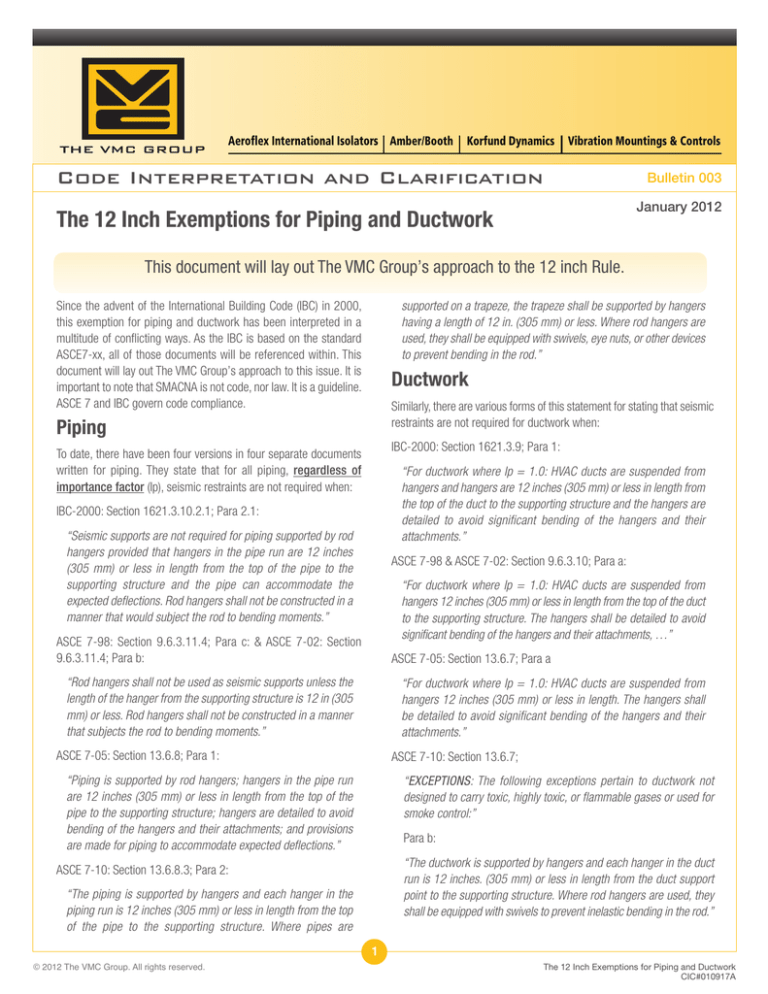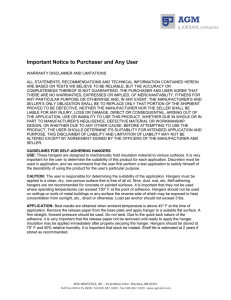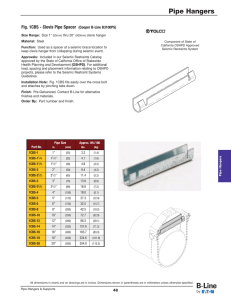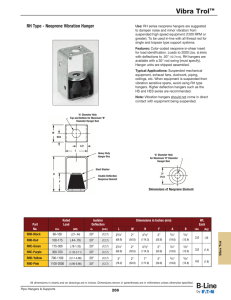
Aeroflex International Isolators Amber/Booth
Korfund Dynamics
Vibration Mountings & Controls
Bulletin 003
Code Interpretation and Clarification
January 2012
The 12 Inch Exemptions for Piping and Ductwork
This document will lay out The VMC Group’s approach to the 12 inch Rule.
Since the advent of the International Building Code (IBC) in 2000,
this exemption for piping and ductwork has been interpreted in a
multitude of conflicting ways. As the IBC is based on the standard
ASCE7-xx, all of those documents will be referenced within. This
document will lay out The VMC Group’s approach to this issue. It is
important to note that SMACNA is not code, nor law. It is a guideline.
ASCE 7 and IBC govern code compliance.
supported on a trapeze, the trapeze shall be supported by hangers
having a length of 12 in. (305 mm) or less. Where rod hangers are
used, they shall be equipped with swivels, eye nuts, or other devices
to prevent bending in the rod.”
Ductwork
Similarly, there are various forms of this statement for stating that seismic
restraints are not required for ductwork when:
Piping
IBC-2000: Section 1621.3.9; Para 1:
To date, there have been four versions in four separate documents
written for piping. They state that for all piping, regardless of
importance factor (Ip), seismic restraints are not required when:
“For ductwork where Ip = 1.0: HVAC ducts are suspended from
hangers and hangers are 12 inches (305 mm) or less in length from
the top of the duct to the supporting structure and the hangers are
detailed to avoid significant bending of the hangers and their
attachments.”
IBC-2000: Section 1621.3.10.2.1; Para 2.1:
“Seismic supports are not required for piping supported by rod
hangers provided that hangers in the pipe run are 12 inches
(305 mm) or less in length from the top of the pipe to the
supporting structure and the pipe can accommodate the
expected deflections. Rod hangers shall not be constructed in a
manner that would subject the rod to bending moments.”
ASCE 7-98 & ASCE 7-02: Section 9.6.3.10; Para a:
“For ductwork where Ip = 1.0: HVAC ducts are suspended from
hangers 12 inches (305 mm) or less in length from the top of the duct
to the supporting structure. The hangers shall be detailed to avoid
significant bending of the hangers and their attachments, …”
ASCE 7-98: Section 9.6.3.11.4; Para c: & ASCE 7-02: Section
9.6.3.11.4; Para b:
ASCE 7-05: Section 13.6.7; Para a
“Rod hangers shall not be used as seismic supports unless the
length of the hanger from the supporting structure is 12 in (305
mm) or less. Rod hangers shall not be constructed in a manner
that subjects the rod to bending moments.”
“For ductwork where Ip = 1.0: HVAC ducts are suspended from
hangers 12 inches (305 mm) or less in length. The hangers shall
be detailed to avoid significant bending of the hangers and their
attachments.”
ASCE 7-05: Section 13.6.8; Para 1:
ASCE 7-10: Section 13.6.7;
“Piping is supported by rod hangers; hangers in the pipe run
are 12 inches (305 mm) or less in length from the top of the
pipe to the supporting structure; hangers are detailed to avoid
bending of the hangers and their attachments; and provisions
are made for piping to accommodate expected deflections.”
“EXCEPTIONS: The following exceptions pertain to ductwork not
designed to carry toxic, highly toxic, or flammable gases or used for
smoke control:”
Para b:
“The ductwork is supported by hangers and each hanger in the duct
run is 12 inches. (305 mm) or less in length from the duct support
point to the supporting structure. Where rod hangers are used, they
shall be equipped with swivels to prevent inelastic bending in the rod.”
ASCE 7-10: Section 13.6.8.3; Para 2:
“The piping is supported by hangers and each hanger in the
piping run is 12 inches (305 mm) or less in length from the top
of the pipe to the supporting structure. Where pipes are
1
© 2012 The VMC Group. All rights reserved.
The 12 Inch Exemptions for Piping and Ductwork
CIC#010917A
Note that for ASCE 7-10, the exception for ductwork that has an Ip
of 1.5 has been relaxed slightly.
Summary
For ductwork, all codes allow for other referenced standards to be
deemed acceptable if approved by the authority having jurisdiction.
This is meant to allow seismic restraints installed per SMACNA to be
acceptable, but only if the specific Authority Having Jurisdiction (AHJ)
accepts it, which is not always the case.
For both piping and ductwork in ASCE7-10 the concept of swivels has
come up. The VMC Group will use this latest version of the code as our
standard going forward. We will utilize our isolation hangers as the “other
devices to prevent bending in the rod.” When installed properly, our
rubber and/or spring hanger boxes will act as a moment release, and
therefore, not allow the rod to bend.
SMACNA Seismic Restraint Manual, Second Edition (1998): Section 3.2:
One other noticeable change is the allowance, in ASCE7-10, of some
ductwork with an Ip of 1.5 as being allowed to have the exemption.
Alternatively, SMACNA now excludes all ductwork with an Ip of 1.5 from
being exempt. The VMC Group will follow the ASCE7 code when allowing
this exemption for certain ductwork where Ip = 1.5.
“No bracing is required if the duct is suspended by hangers 12
inches or less in length, as measured from the top of the duct
to the bottom of the support where the hanger is attached.
Hangers must be positively attached to the duct within 2 inches
of the top of the duct with a minimum of two #10 sheet metal
screws.”
In all cases, the requirement needs to be met for the complete run. For
installations where a significant portion of the run is within 12”, bracing
only will be required at those locations with rod lengths greater than 12”,
providing isolation hangers are used at the other locations.
SMACNA Seismic Restraint Manual, Third Edition (2008): Section 3.3:
“Seismic supports are not required for HVAC ductwork when the Ip
= 1.0 if … the following condition(s) is met for the entire duct run:
If you have any questions regarding the 12 Inch Exemptions for Piping
and Ductwork, or if you wish to receive additional copies of our Code
Interpretation and Clarification by The VMC Group, please contact
ibcinfo@thevmcgroup.com.
a. Ducts are suspended from hangers 12 inches or less as
measured from the top of the duct to the bottom of the support
where the hanger is attached. Hangers must be positively
attached to the duct within 2 inches of the top of the duct with
a minimum of two #10 sheet metal screws. Lateral motion will
not cause damaging impact with other systems. Lateral motion
will not cause loss of vertical support”
About the Author...
Mr. John P. Giuliano, PE, incorporates his engineering
and business management experience in his capacity
as President of The VMC Group. His comprehensive
experience and knowledge in vibration isolation, seismic
design and code compliance has made him a pioneer
in helping define requirements for certification
methodologies of non-structural building components
in the areas of HVAC, power generation and fire
protection. John has an engineering degree and a
specialty in economics from Polytechnic Institute of
New York. He is a licensed Civil/Structural Professional
Engineer in the state of NY. Prior to joining VMC, he
spent 12 years in the aerospace industry working at
Northrop-Grumman and Lockheed Martin in the design
of military aircraft. Mr. Giuliano is also a founding
member of VISCMA (Vibration Isolation and Seismic
Controls Manufacturers Association) and has been
actively involved with this organization since its
inception. He is also a member of ASHRAE (American
Society of Heating, Refrigeration and Air Conditioning
Engineers), ICBO (International Conference of Building
Officials), and BSSC (Building Seismic Safety Council).
2
© 2012 The VMC Group. All rights reserved.
The 12 Inch Exemptions for Piping and Ductwork
CIC#010917A
About The VMC Group...
The VMC Group is comprised of four leading global brands that together represent the state of the art in shock, vibration, seismic and noise control.
Vibration Mountings & Controls has delivered innovative vibration isolation products and solutions to the HVAC industry for over 65 years
Aeroflex International Isolators has provided mission critical products and solutions to leading military, aerospace and defense companies for more than
35 years.
Korfund Dynamics has delivered cutting edge products and solutions to global leaders in the industrial machinery, construction equipment, and power
generation industries for over 100 years.
Amber/Booth has provided quality products to the HVAC, defense, transportation and OEM markets for over 60 years. Amber/Booth is a member of the
Vibration Isolation and Seismic Control Manufacturers Association (VISCMA, www.viscma.com) and the American Society of Heating, Refrigerating, and
Air-Conditioning Engineers, Inc. (ASHRAE, www.ashrae.org).
We offer one of the most extensive product lines in the industry. Our engineering staff is comprised of mechanical and structural engineers with
industry-recognized credentials in structural analysis, elastomer development, machine design and system dynamics. We understand how to customize
components, materials and configurations to perfectly meet your needs.
Additionally, our engineering staff includes leading structural engineers with industry-recognized credentials in structural analysis, IBC seismic
qualification and wind certification services, OSHPD pre-approval services, seismic project management, seismic and wind engineering design, bomb
blast and shock modeling and system dynamics.
As a certified seismic qualification agency for IBC code compliance, The VMC Group can help you through the seemingly daunting task of equipment
qualification and certification. With our turnkey solutions for IBC Certification and OSHPD Seismic Qualifications, we will manage all aspects of your
project including: Development of product matrices; Management of shake table testing; Performance of structural analysis and mathematical modeling
(FEA modeling), as well as Issuance of the certificates of compliance and product labeling required by the code
Our engineering services, manufacturing facilities and corporate offices are located in Bloomingdale, New Jersey with additional manufacturing and
engineering offices located in Houston, Texas and Sacramento, California.
Corporate 113 Main Street, PO Box 270 • Bloomingdale, NJ 07403
Texas 11930 Brittmoore Park Drive • Houston, TX 77041
California 980 9th Street, 16th Floor • Sacramento, CA 95814
For more information email: ibcinfo@thevmcgroup.com
www.thevmcgroup.com • Toll Free: 1-800-LOW-VIBE
3
© 2012 The VMC Group. All rights reserved.
The 12 Inch Exemptions for Piping and Ductwork
CIC#010917A





